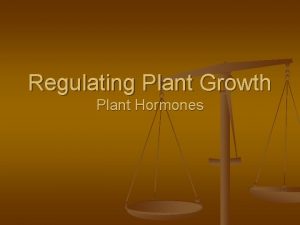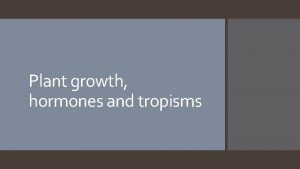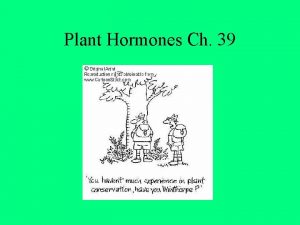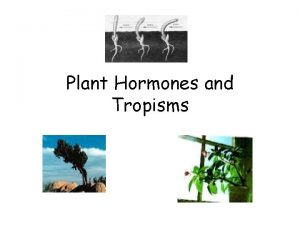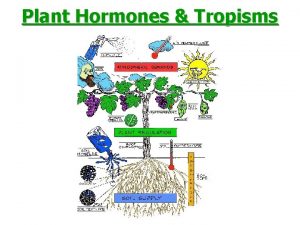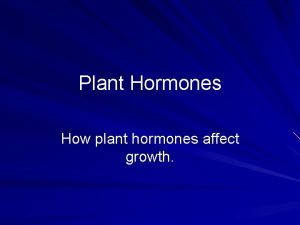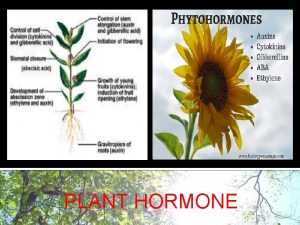PLANT HORMONES Hormones Chemical messenger that stimulates or














- Slides: 14

PLANT HORMONES

Hormones • Chemical messenger that stimulates or suppresses the activity of cells • Produced in one location of an organism and causes a response in another

Gibberellins • Dramatic increase in size • End seed dormancy, start germination. And promote rapid growth of seedlings. • Big fruit, long stems

Ethylene • Causes ripening • Naturally produced by the plant

Cytokinins • Stimulate cytokinesis ( last stage of cell division) • Produced in growing roots, seed, and fruits • Lateral growth- side branches

Auxins • Lengthening of plant- apical meristem • Stimulate growth of the primary stem-preventing growth of new branches. • Controls some forms of tropism

PLANT RESPONSES

Tropisms are a plant’s response to conditions in the environment. The responses can be affected by gravity, light, touch, and seasonal changes.

TROPISMS – Gravitropism – Phototropism – Thigmotropism

Gravitropism - Up and down growth of a plant - Plant responding to gravity - Down ( +) – with gravity - Up (-)- against gravity

Phototropism A phototropic response is when a plant grows toward a source of light. Stems may bend toward a window or nearest source of light. This growth allows their leaves to capture the most sunlight for the process of photosynthesis.

Thigmotropism • When plants respond to touch • Climbing plants/vines

Thigmotropism Examples: – A plant that is touched regularly may be stunted in its growthsometimes quite dramatically – Vines and climbing plants-tips wrap around objects

Rapid Responses • Some responses do not involve growth; they are not tropisms • Examples: – Mimosa pudica: the “sensitive plant” – The Venus flytrap
 What are the two main parts of a lipid?
What are the two main parts of a lipid? Tìm vết của đường thẳng
Tìm vết của đường thẳng Sau thất bại ở hồ điển triệt
Sau thất bại ở hồ điển triệt Thơ thất ngôn tứ tuyệt đường luật
Thơ thất ngôn tứ tuyệt đường luật Con hãy đưa tay khi thấy người vấp ngã
Con hãy đưa tay khi thấy người vấp ngã Thơ thất ngôn tứ tuyệt đường luật
Thơ thất ngôn tứ tuyệt đường luật Tôn thất thuyết là ai
Tôn thất thuyết là ai Phân độ lown
Phân độ lown Chiến lược kinh doanh quốc tế của walmart
Chiến lược kinh doanh quốc tế của walmart Gây tê cơ vuông thắt lưng
Gây tê cơ vuông thắt lưng Block xoang nhĩ là gì
Block xoang nhĩ là gì Salad accompaniments enhance appetite
Salad accompaniments enhance appetite Insulin stimulates
Insulin stimulates Explain how amp stimulates cellular respiration
Explain how amp stimulates cellular respiration Plant hormones and responses
Plant hormones and responses
















